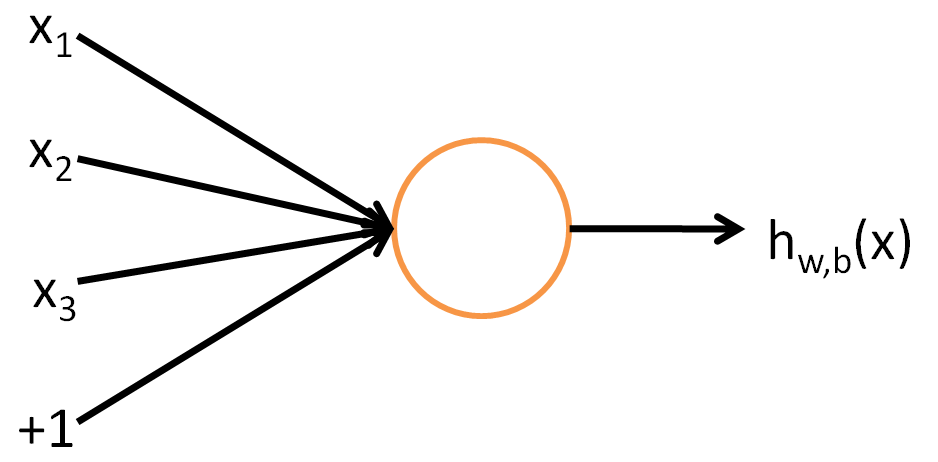-
机器学习按大功能来区分包含两类
- 监督学习,需要有经过标注的结果,说明入参对应的结果,用于解决分类、拟合等问题。
- 无监督学习,无需经过标注的结果,用于分析数据间的聚合关联关系,
-
在监督学习算法按实现的功能有两大类型
- 分类算法(用于给定参数推定所属的坆举分类)
- 回归算法(拟合曲线方程,并根据入参算出曲线入参的结果,回归能得出连续的结果)
-
一些监督算法
-
线性回归,可以有多个入参,但是入参对应的幂指数都是1
- 非线性回归可以转化成线性回归处理
-
Logistic回归,其基于Sigmoid函数,该函数结果介于0-1之间,其结合线性/非线性回归,可用于判断一件事情发生的概率。其是神经网络的基础,神经网络由多个该年该层组成
-
神经网络(深度学习属于神经网络,后面的算法若不感兴趣可以直接跳过,本节仅仅用于说明监督算法有很多分类,下面会详细一点的介绍神经网络)
-
kNN算法,根据代数最短距离挑出最近的k个已知学习样本,并以样本的平均值(或者分类结果)作为推断值
-
朴素贝叶斯算法,有很多个对结果有影响的参数,并假设这些参数都是独立发生,没有相互关联的,然后统计这些参数在某个结论中出现的概率,根据这些概率推断特定入参对应最可能的结果是什么
-
决策树算法,根据训练样本的入参及结果,结合各个参数信息增熵的信息构造一个高效的分类树
-
-
神经网络
- 所谓神经网络学习的过程可以想象成解方程的过程,例如 y=ax+b,如果我们知道了 y 和 x的2个值,那么我们就可以求得a跟b的值。求得a跟b的值就是整个训练的最终目的
- 但是实际情况下训练过程会复杂很多,我们之前有将到,神经网络的基础是Logistic回归,一个Logistic回归函数可对应为一个神经元,其函数形式可为 y = sigmoid(a0 + a1*x1 + a2 * x2 + ......)。我们实际上是不知道x的实际有效个数,也不知道其对应的合适幂等次数,所以我们很难像解方程一样解出各个a的值,通常求a的值是利用现有的所有训练样例,求得针对所有样例能获得一个最小化误差的a的值。求a值通常会用梯度下降及其相关优化的算法。具体感兴趣可以自行学习。
- 而神经网络由多个神经元堆叠而成,以下第一个图为单个神经元,第二个图为神经网络


-
深度学习
- 所谓深度学习就是计算由很多个层次(见上图的Layer)的神经网络的各个a(权重)的值,并没有什么玄乎的东西,其是一个商业概念
- 但从上图可以看出,深度神经网络的计算量非常的大,这也是为什么在之前深度学习没有火起来的原因,为了减轻计算量提高效率,神经网络有针对不同场景的优化分支,有以下几类
- 卷积神经网络
- 卷积神经网络,会局部的抽取计算小特征,并在高层的layer根据小特征计算大特征,最终得到推论结果。其多用于图像处理
- 循环神经网络
- 其用于不能一次获得所有输入的场景,其能记录之前输入数据的状态,并以此加以训练。例如语音转文字处理场景,其能根据新的语音输入,以及之前转出来的文字统一作为入参,推断出下一个要转换的语音对应的文字
-
基于KERAS的深度学习开发
- 实际上基于KERAS的开发特别简单,我们要做的仅仅是搭积木
- 根据我们现有的场景,选择组合特定适合的神经网络,就是工作的最主要部分,当然,前提就是我们需要熟悉各种神经网络的有缺点
- 因此深度学习开发,可以说作出基本成果是难度不的,难度大的是,如何选择出合适的神经网络,拼凑出合适的模型,使得在足量的训练样本的情况下,训练出准确率高,计算复杂度小模型。
-
以下是一个训练从图片转HTML/CSS的全部开发代码,大家可以感受下其代码量
from numpy import array from keras.preprocessing.text import Tokenizer, one_hot from keras.preprocessing.sequence import pad_sequences from keras.models import Model, Sequential, model_from_json from keras.utils import to_categorical from keras.layers.core import Dense, Dropout, Flatten from keras.optimizers import RMSprop from keras.layers.convolutional import Conv2D from keras.callbacks import ModelCheckpoint from keras.layers import Embedding, TimeDistributed, RepeatVector, LSTM, concatenate , Input, Reshape, Dense from keras.preprocessing.image import array_to_img, img_to_array, load_img import numpy as np Using TensorFlow backend. # In [2]: dir_name = '/data/train/'# Read a file and return a string
def load_doc(filename):
file = open(filename, 'r')
text = file.read()
file.close()
return textdef load_data(data_dir):
text = []
images = []
# Load all the files and order them
all_filenames = listdir(data_dir)
all_filenames.sort()
for filename in (all_filenames):
if filename[-3:] == "npz":
# Load the images already prepared in arrays
image = np.load(data_dir+filename)
images.append(image['features'])
else:
# Load the boostrap tokens and rap them in a start and end tag
syntax = '<START> ' + load_doc(data_dir+filename) + ' <END>'
# Seperate all the words with a single space
syntax = ' '.join(syntax.split())
# Add a space after each comma
syntax = syntax.replace(',', ' ,')
text.append(syntax)
images = np.array(images, dtype=float)
return images, texttrain_features, texts = load_data(dir_name)
# In [4]:
# Initialize the function to create the vocabulary
tokenizer = Tokenizer(filters='', split=" ", lower=False)
# Create the vocabulary
tokenizer.fit_on_texts([load_doc('bootstrap.vocab')])# Add one spot for the empty word in the vocabulary
vocab_size = len(tokenizer.word_index) + 1
# Map the input sentences into the vocabulary indexes
train_sequences = tokenizer.texts_to_sequences(texts)
# The longest set of boostrap tokens
max_sequence = max(len(s) for s in train_sequences)
# Specify how many tokens to have in each input sentence
max_length = 48def preprocess_data(sequences, features):
X, y, image_data = list(), list(), list()
for img_no, seq in enumerate(sequences):
for i in range(1, len(seq)):
# Add the sentence until the current count(i) and add the current count to the output
in_seq, out_seq = seq[:i], seq[i]
# Pad all the input token sentences to max_sequence
in_seq = pad_sequences([in_seq], maxlen=max_sequence)[0]
# Turn the output into one-hot encoding
out_seq = to_categorical([out_seq], num_classes=vocab_size)[0]
# Add the corresponding image to the boostrap token file
image_data.append(features[img_no])
# Cap the input sentence to 48 tokens and add it
X.append(in_seq[-48:])
y.append(out_seq)
return np.array(X), np.array(y), np.array(image_data)X, y, image_data = preprocess_data(train_sequences, train_features)
In [ ]:
#Create the encoder
image_model = Sequential()
image_model.add(Conv2D(16, (3, 3), padding='valid', activation='relu', input_shape=(256, 256, 3,)))
image_model.add(Conv2D(16, (3,3), activation='relu', padding='same', strides=2))
image_model.add(Conv2D(32, (3,3), activation='relu', padding='same'))
image_model.add(Conv2D(32, (3,3), activation='relu', padding='same', strides=2))
image_model.add(Conv2D(64, (3,3), activation='relu', padding='same'))
image_model.add(Conv2D(64, (3,3), activation='relu', padding='same', strides=2))
image_model.add(Conv2D(128, (3,3), activation='relu', padding='same'))image_model.add(Flatten())
image_model.add(Dense(1024, activation='relu'))
image_model.add(Dropout(0.3))
image_model.add(Dense(1024, activation='relu'))
image_model.add(Dropout(0.3))image_model.add(RepeatVector(max_length))
visual_input = Input(shape=(256, 256, 3,))
encoded_image = image_model(visual_input)language_input = Input(shape=(max_length,))
language_model = Embedding(vocab_size, 50, input_length=max_length, mask_zero=True)(language_input)
language_model = LSTM(128, return_sequences=True)(language_model)
language_model = LSTM(128, return_sequences=True)(language_model)#Create the decoder
decoder = concatenate([encoded_image, language_model])
decoder = LSTM(512, return_sequences=True)(decoder)
decoder = LSTM(512, return_sequences=False)(decoder)
decoder = Dense(vocab_size, activation='softmax')(decoder)# Compile the model
model = Model(inputs=[visual_input, language_input], outputs=decoder)
optimizer = RMSprop(lr=0.0001, clipvalue=1.0)
model.compile(loss='categorical_crossentropy', optimizer=optimizer)
In [ ]:
#Save the model for every 2nd epoch
filepath="org-weights-epoch-{epoch:04d}--val_loss-{val_loss:.4f}--loss-{loss :.4f}.hdf5"
checkpoint = ModelCheckpoint(filepath, monitor='val_loss', verbose=1, save_weights_only=True, period=2)
callbacks_list = [checkpoint]
In [ ]:
# Train the model
model.fit([image_data, X], y, batch_size=64, shuffle=False, validation_split=0.1, callbacks=callbacks_list, verbose=1, epochs=50)
以上仅为大家提供一个深度学习开发的一个初步概念,本人也在学习中,有错误或者不完善请斧整~
欢迎来到这里!
我们正在构建一个小众社区,大家在这里相互信任,以平等 • 自由 • 奔放的价值观进行分享交流。最终,希望大家能够找到与自己志同道合的伙伴,共同成长。
注册 关于